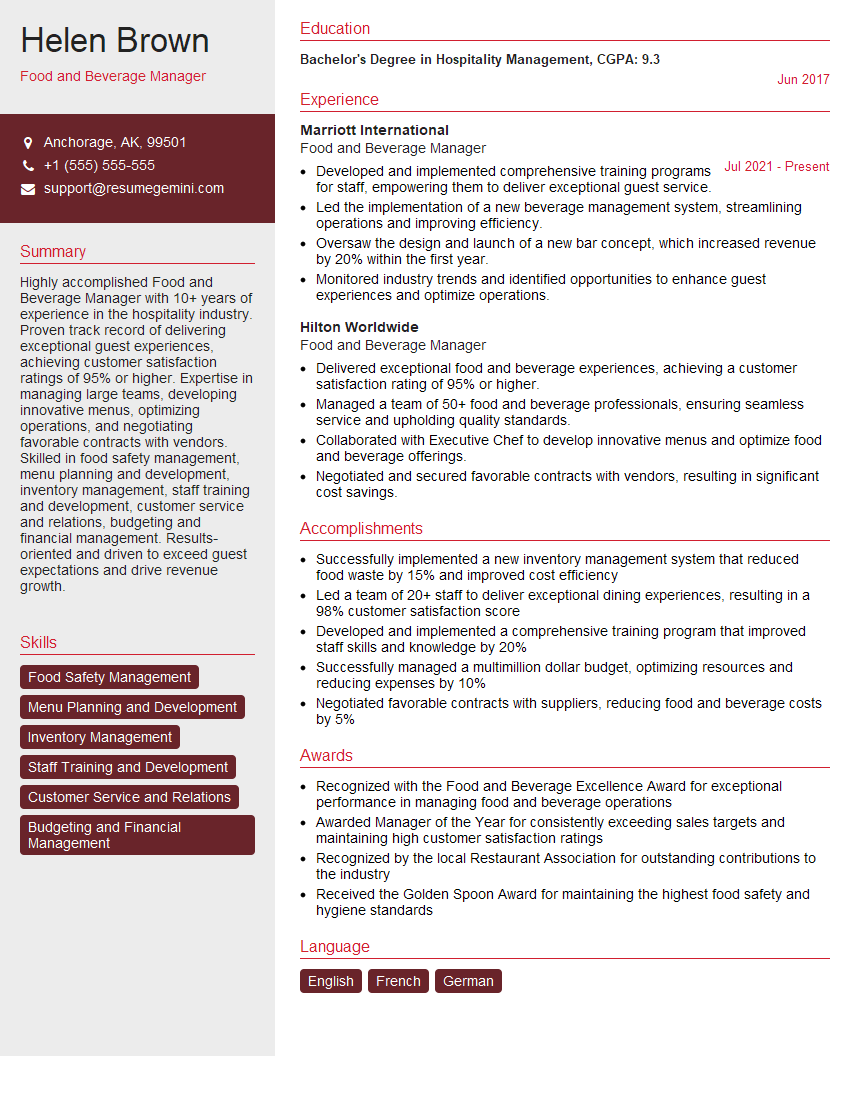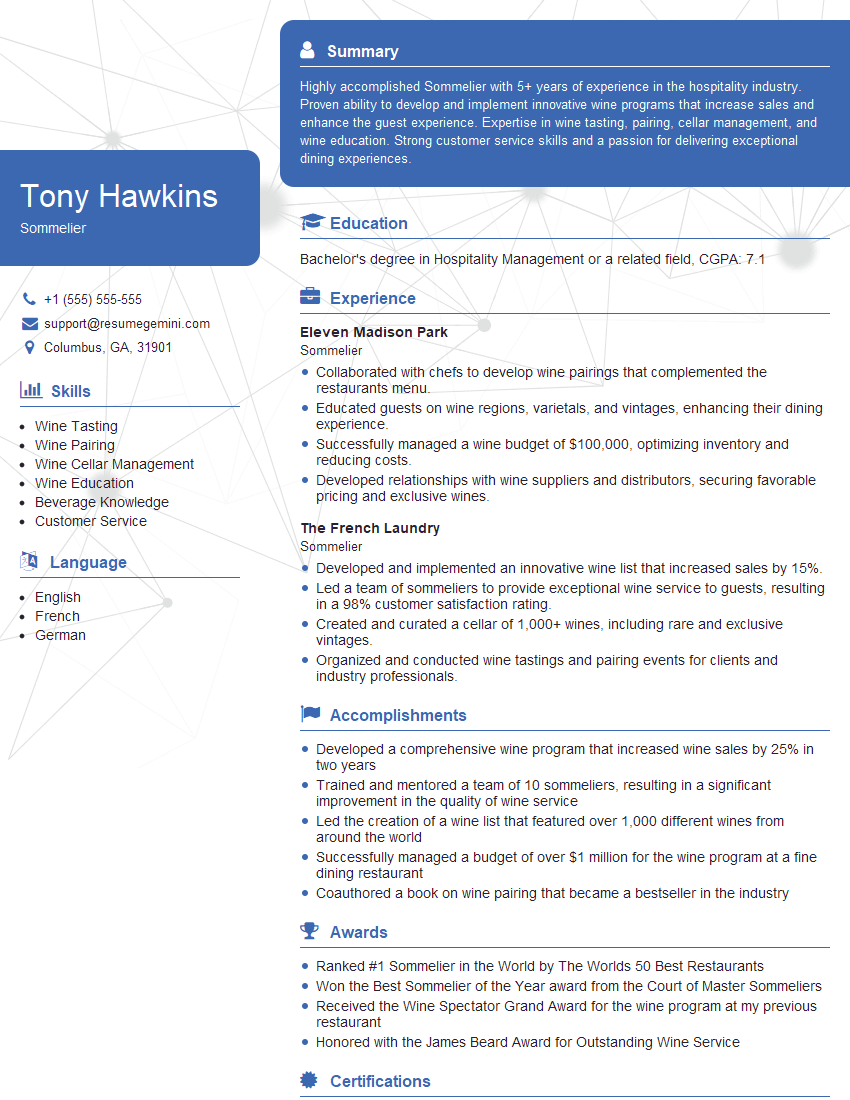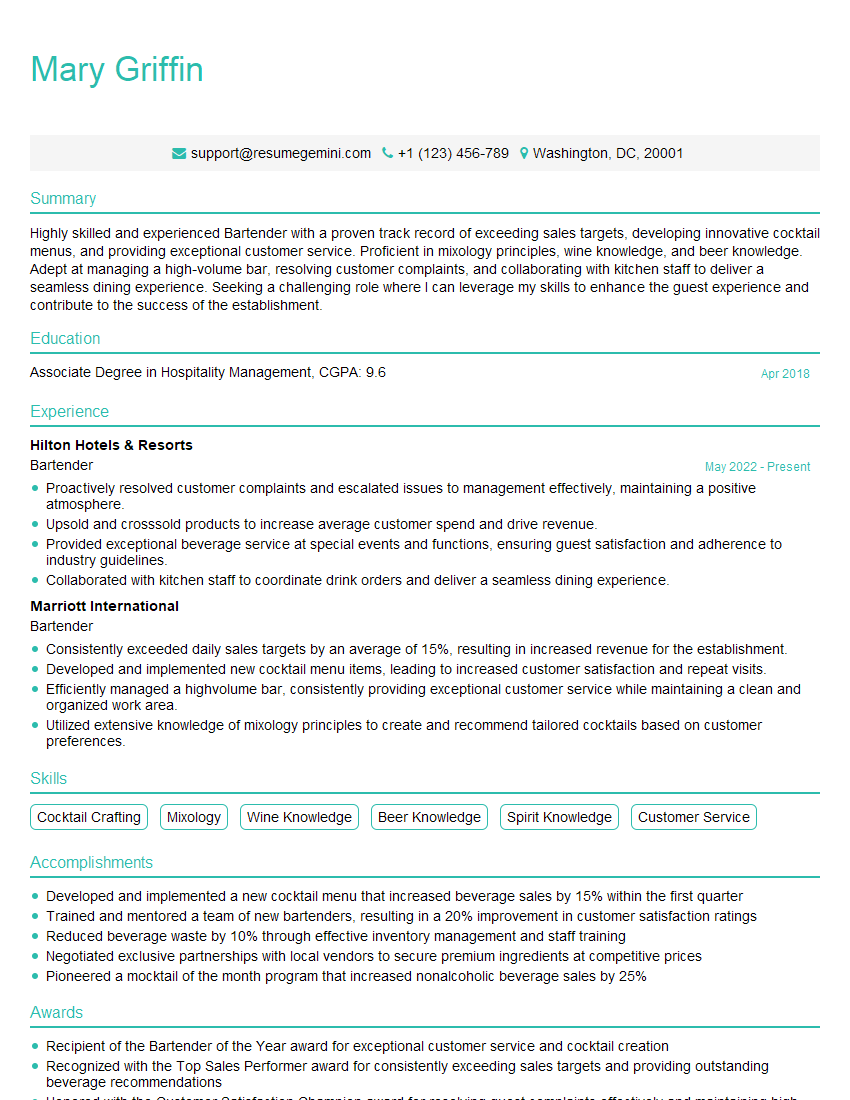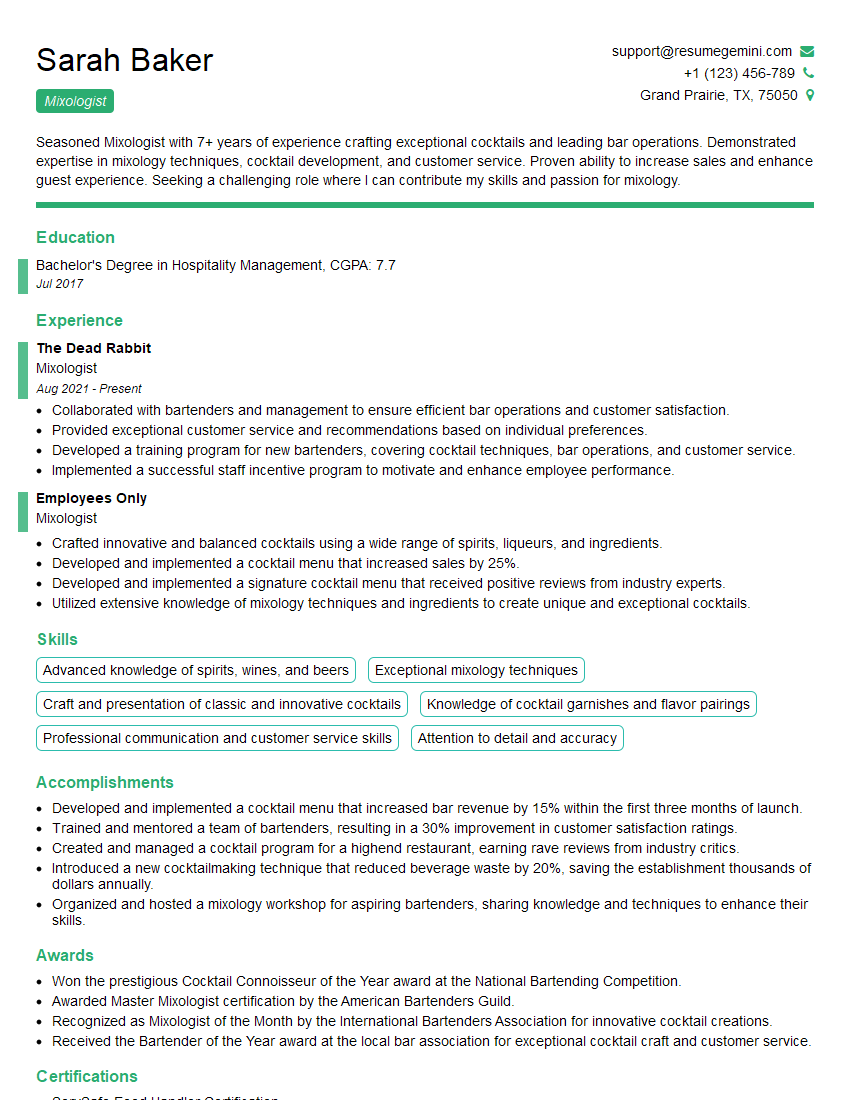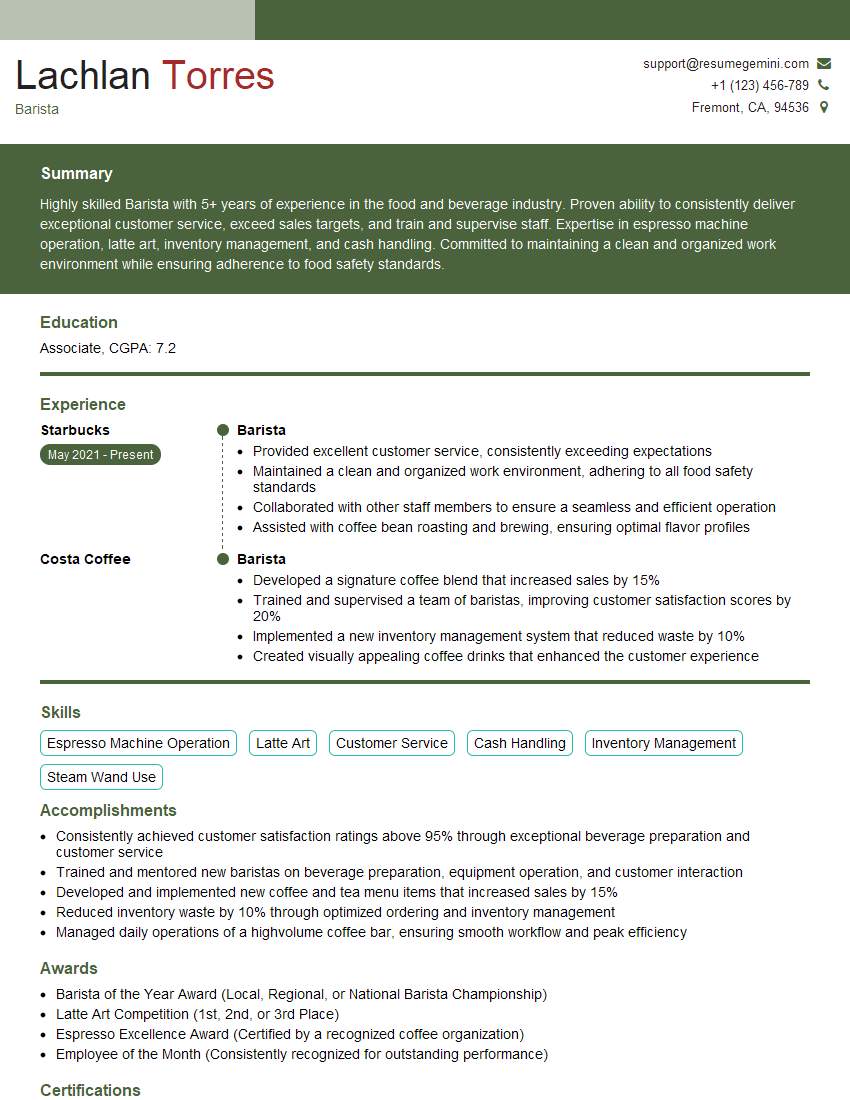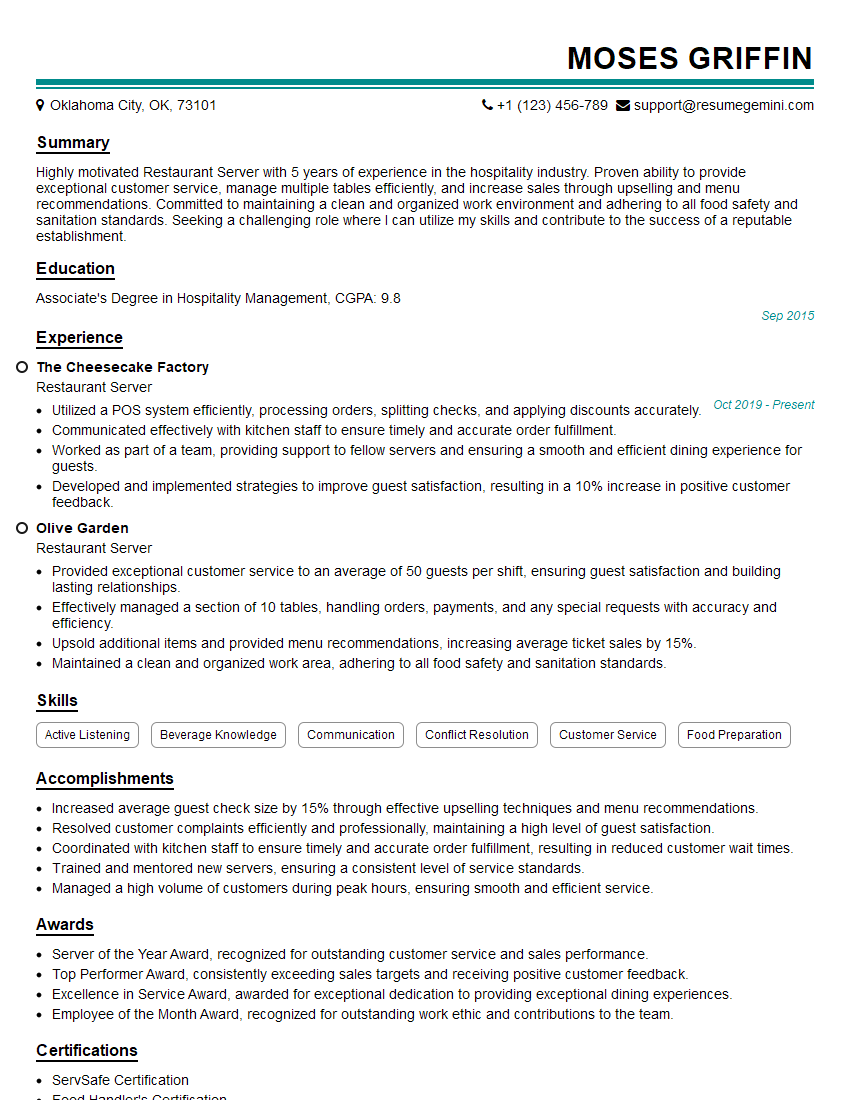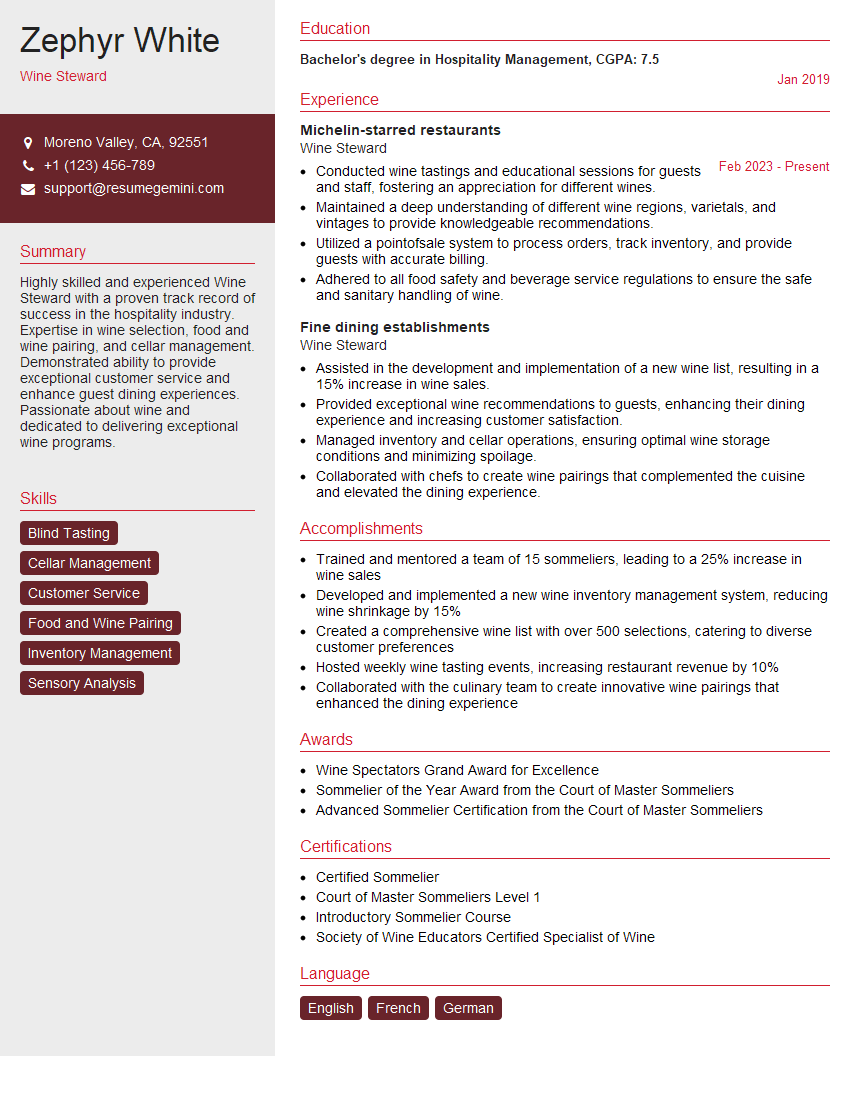Cracking a skill-specific interview, like one for Upselling premium and specialty drinks to enhance customer experience, requires understanding the nuances of the role. In this blog, we present the questions you’re most likely to encounter, along with insights into how to answer them effectively. Let’s ensure you’re ready to make a strong impression.
Questions Asked in Upselling premium and specialty drinks to enhance customer experience Interview
Q 1. What strategies do you employ to identify a customer’s preference for premium drinks?
Identifying a customer’s preference for premium drinks is a nuanced process that goes beyond simply asking if they want something ‘fancy’. It’s about observing their choices and understanding their overall experience. I start by paying attention to their initial drink order. If they order something like a craft beer or a specific type of wine, it signals a potential interest in higher-quality beverages. Their choice of food can also be a helpful indicator. Someone ordering a steak or a gourmet dish might be more inclined towards a premium wine pairing. I also engage in casual conversation, listening for cues about their lifestyle and preferences. For example, mentioning a recent trip to a wine region or an appreciation for fine dining could hint at a readiness to explore premium options.
Beyond direct observation, I utilize suggestive questioning. Instead of directly asking if they want something expensive, I might say, “Our wine list features some exceptional vintages tonight; would you be interested in learning more about what we have available?” or “We have a new cocktail made with artisanal ingredients—it’s quite unique.” This subtle approach respects the customer’s autonomy while guiding them towards premium choices.
Q 2. Describe your approach to suggesting premium drink options to customers.
Suggesting premium drink options requires a delicate balance of knowledge and salesmanship. My approach focuses on personalization and education. I begin by understanding the customer’s current drink selection, then subtly introduce premium alternatives. For example, if they order a standard house wine, I might suggest, “That’s a great choice, but have you considered our Pinot Noir from Burgundy? It pairs beautifully with your meal.” I avoid high-pressure sales tactics; instead, I emphasize the unique aspects of the premium option. This could include highlighting specific flavor notes, the origin of the ingredients, or the craftmanship behind its creation. If they are unsure, I might offer a small taste or a detailed description to help them make an informed decision.
I always ensure that the suggestion aligns with their existing order and preferences. Suggesting a light, fruity cocktail to someone who just ordered a spicy dish wouldn’t make sense. The goal isn’t just to increase revenue, but to enhance their overall experience by offering the perfect beverage accompaniment.
Q 3. How do you handle customer objections to upselling premium drinks?
Handling objections to upselling is crucial. I approach objections with empathy and understanding. I listen carefully to their concerns, acknowledging their perspective before addressing them. Common objections include price or unfamiliarity with the drink. If price is a concern, I might highlight the value proposition by emphasizing the quality of ingredients, unique taste profile, or the experience it offers. I may also suggest a smaller portion or offer a substitute that offers similar premium quality at a slightly lower price point.
For example, if a customer says, “That’s too expensive,” I might respond, “I understand. However, this particular [Drink Name] uses hand-selected ingredients and a unique preparation method that results in a truly exceptional flavor profile. Would you like me to tell you more about the process?” By reframing the objection and focusing on the value rather than just the price, I can often overcome the resistance.
Q 4. What are some common techniques used to effectively upsell specialty drinks?
Effective upselling of specialty drinks relies on a combination of techniques. One is highlighting the unique selling points. This could include describing the handcrafted nature of a cocktail, mentioning limited-time seasonal ingredients, or showcasing award-winning coffees or teas. Another powerful technique is storytelling. Sharing the story behind a drink—its origin, the inspiration behind its creation, or the passion of the bartender—can create a stronger emotional connection with the customer and make the upsell more compelling.
Visual presentation is also key. A beautifully crafted cocktail or a neatly presented dessert wine will appeal more strongly than a less-aesthetically-pleasing option. Finally, offering a tasting or sampler can be a risk-free way for the customer to explore a premium drink before committing to a full purchase.
Q 5. How do you highlight the value proposition of premium drinks to customers?
Highlighting the value proposition of premium drinks involves showcasing what sets them apart from standard options. This goes beyond just stating the price. Instead, I emphasize the superior quality of ingredients, the craftsmanship involved in their creation, and the overall experience they provide. For instance, I might explain that a particular whiskey is aged for a longer period, giving it a smoother, richer taste. Or I might highlight the locally sourced, organic ingredients in a specialty cocktail. I might also mention any accolades or awards the drink has received.
By focusing on the sensory experience—the aroma, the taste, the texture—I help the customer understand the added value they are receiving. It’s about selling an experience, not just a drink.
Q 6. Explain your process for recommending complementary pairings of food and drinks.
Recommending complementary food and drink pairings is a skill that requires both product knowledge and understanding of flavor profiles. My process begins by identifying the customer’s food order. I then use my expertise to suggest a drink that enhances the flavors of the dish without overpowering it. For a rich, savory dish like steak, I might recommend a full-bodied red wine with notes of oak and black fruit. For a lighter, seafood dish, I might suggest a crisp white wine with citrusy notes. The goal is to create a harmonious combination that elevates the dining experience.
I also consider the customer’s personal preferences. If they express a dislike for certain flavors or types of alcohol, I tailor my suggestions accordingly. I don’t just recite pre-defined pairings; I use my knowledge to create a customized experience that suits each individual customer.
Q 7. How do you stay informed about new specialty drinks and trends?
Staying informed about new specialty drinks and trends is an ongoing process. I regularly attend industry events, workshops, and trade shows to learn about the latest products and techniques. I also subscribe to industry publications and follow influential figures on social media. I make a point to try new drinks at different establishments, expanding my own tasting experience and understanding of emerging trends. Online resources, including blogs and specialized websites dedicated to beverages, provide valuable insight into the latest innovations.
Furthermore, I maintain close relationships with beverage suppliers and distributors, who regularly update me on new product releases and market trends. Staying informed ensures that I’m always equipped to offer the most current and exciting options to my customers, enhancing their experience and driving sales.
Q 8. Describe a time you successfully up-sold a premium drink and the techniques employed.
One time, a customer ordered a regular latte. I noticed she was reading a magazine about travel and seemed to be enjoying a moment of quiet relaxation. Instead of simply handing her the latte, I initiated a conversation about her magazine. This led to a natural discussion about experiencing new things and indulging in little luxuries. I then suggested our ‘Signature Mocha,’ highlighting its rich, handcrafted chocolate and its use of premium ethically-sourced cocoa beans. I emphasized the experience – the aroma, the creamy texture – linking it to the feeling of relaxation and escape she was already experiencing. She agreed and absolutely loved it. The techniques I employed were:
- Active Listening and Observation: I paid attention to her body language and conversation starters to tailor my suggestion.
- Building Rapport: I initiated a friendly conversation to establish trust and create a connection.
- Highlighting the Value Proposition: Instead of just mentioning the price difference, I emphasized the superior quality and enhanced experience.
- Suggestive Selling: I presented the premium option as a natural upgrade rather than a forceful sales pitch.
Q 9. How do you personalize your upselling approach to different customer profiles?
Personalization is key to successful upselling. My approach varies based on observable customer profiles. For example:
- Busy Professionals: I might suggest a quick, high-quality espresso-based drink, emphasizing its energizing properties and convenient nature. A quick ‘Espresso Macchiato’ versus a longer ‘Cappuccino’ is efficient and still premium.
- Relaxed Patrons: I’d offer premium blends or specialty drinks with unique flavor profiles, highlighting the experience and opportunity for indulgence. A ‘Lavender Honey Latte’ or a ‘Salted Caramel Mocha’ speak to moments of peaceful escape.
- Health-Conscious Customers: I would showcase options with less sugar or healthier alternatives like almond or oat milk, emphasizing the quality ingredients and nutritional aspects of our beverages. A ‘Cold Brew with Almond Milk and a touch of Stevia’ can be very appealing.
- First-Time Visitors: I usually start with their basic order and then present one premium upgrade to avoid overwhelming them. For example, ‘Our house blend is delicious, but our single-origin Ethiopian Yirgacheffe has a delightful bright citrus flavor profile you might enjoy’.
I observe body language, listen to their conversations, and even subtly use the information they provide (like what they order initially) to tailor the experience and upsell.
Q 10. What is your knowledge of different coffee beans and their flavor profiles?
My knowledge of coffee beans encompasses various regions, processing methods, and flavor profiles. For instance:
- Arabica: Generally known for its smooth, sweet, and aromatic qualities, Arabica beans from Ethiopia (like Yirgacheffe) exhibit bright citrus and floral notes; those from Kenya boast a bright acidity and black currant flavors; and Sumatran beans often have a full body with earthy and spicy notes.
- Robusta: Higher in caffeine content and characterized by its strong, bitter, and nutty flavor, often used in espresso blends for its crema and body.
I understand the nuances of different roasts – light roasts accentuate the bean’s origin characteristics, medium roasts offer a balanced profile, and dark roasts feature intense, often smoky, flavors. I can effectively communicate these distinctions to customers, guiding them toward selections that align with their preferences.
Q 11. What types of specialty cocktails are you familiar with, and what are their unique characteristics?
I’m familiar with a wide range of specialty cocktails, including:
- Espresso Martini: A classic cocktail combining vodka, coffee liqueur, and espresso, known for its bold and invigorating flavor.
- Irish Coffee: A comforting drink blending hot coffee, Irish whiskey, and sugar, offering a warm and sweet taste.
- Mojito: A refreshing cocktail featuring white rum, mint leaves, sugar, lime juice, and club soda, ideal for warm weather.
- Margarita: A popular tequila-based cocktail with lime juice and orange liqueur, offering a zesty and tart flavor profile.
- Old Fashioned: A sophisticated cocktail made with bourbon or rye whiskey, sugar, bitters, and an orange twist, known for its smooth and complex taste.
I can discuss the unique characteristics of each, including the balance of flavors, the history, and ideal preparation methods, helping customers select based on their taste profiles and desired experience. The key is knowing how to describe the nuances of each drink in a way that is both informative and exciting.
Q 12. How do you handle situations where a customer’s budget is a constraint?
Budget constraints are a valid concern. If a customer mentions budget as a factor, I would never pressure them. Instead, I offer alternatives that still provide a value-added experience without breaking their budget. For example:
- Suggesting a smaller size of a premium drink: A smaller ‘single-origin’ espresso instead of a larger, more expensive version could still offer the superior taste experience.
- Highlighting daily specials or discounts: Many establishments have happy hour pricing or discounted items, this can be the perfect opportunity to suggest the drink in a budget-friendly way.
- Offering a substitute with similar flavor profiles: If a premium drink is too expensive, I can suggest an alternative drink with a similar flavor profile but using more readily available ingredients and at a better price point.
- Emphasizing the long-lasting enjoyment: For example, a more expensive tea could be described as a truly relaxing experience that will last longer than a quick coffee.
The key is to be flexible, understanding, and to suggest alternatives that still meet the customer’s desire for a quality drink without exceeding their financial comfort zone. Respecting their budget builds trust.
Q 13. What are some ethical considerations in upselling premium drinks?
Ethical considerations in upselling premium drinks center around transparency, honesty, and respecting customer autonomy. Key aspects include:
- Transparency about pricing and ingredients: Clearly communicate the price difference and justify it by highlighting the superior quality, unique ingredients, or enhanced preparation methods.
- Avoiding manipulative tactics: Refrain from using high-pressure sales techniques or misleading information. Upselling should enhance the customer’s experience, not exploit them.
- Respecting the customer’s decision: Accept a ‘no’ gracefully and avoid pressuring the customer into a purchase they don’t want. Their comfort level should always be prioritized.
- Focusing on value, not just price: Emphasize the added value that the premium drink provides – a richer taste, a unique experience, an opportunity for a treat.
Ethical upselling is about guiding customers to choices that genuinely align with their needs and preferences while fostering a positive and trustworthy relationship.
Q 14. How would you address a customer who feels pressured by your upselling attempts?
If a customer feels pressured, the first step is to acknowledge their feelings immediately. I would apologize sincerely, stating something like, ‘I apologize if I came across as pushy; I didn’t intend to pressure you.’ I would then take a step back, assuring them that the decision is entirely theirs. I might say something like:
‘I understand you’re feeling pressured; I want you to enjoy your drink without feeling obligated. Perhaps we can talk about other options, or I can just get you your original order.’ I would then offer them their original choice promptly and ensure a positive experience with our service.
This approach demonstrates respect for their autonomy, addresses their concerns directly, and helps regain their trust. The focus shifts from the sale to ensuring customer satisfaction, ultimately protecting the business’ reputation.
Q 15. What is your understanding of the cost structure and profit margins associated with premium drinks?
Understanding the cost structure and profit margins of premium drinks is crucial for successful upselling. It involves analyzing several key components. Firstly, we have the direct costs: the raw ingredients (e.g., high-quality coffee beans, specific teas, premium spirits), any specialty syrups or garnishes, and the actual cost of the beverage itself. Then there are indirect costs, such as labor costs associated with preparation (especially for complex cocktails), storage, and potential wastage. Finally, we have overhead costs that factor into the overall price—rent, utilities, marketing etc. Profit margins are calculated by subtracting these total costs from the selling price, with premium drinks often carrying a higher markup compared to standard offerings to reflect their higher quality and perceived value. For example, a handcrafted cocktail might have a higher profit margin than a standard espresso due to the higher cost of ingredients, specialized preparation techniques, and a larger perceived value added by the presentation. Regularly tracking these costs and margins helps optimize pricing and ensures profitability.
Career Expert Tips:
- Ace those interviews! Prepare effectively by reviewing the Top 50 Most Common Interview Questions on ResumeGemini.
- Navigate your job search with confidence! Explore a wide range of Career Tips on ResumeGemini. Learn about common challenges and recommendations to overcome them.
- Craft the perfect resume! Master the Art of Resume Writing with ResumeGemini’s guide. Showcase your unique qualifications and achievements effectively.
- Don’t miss out on holiday savings! Build your dream resume with ResumeGemini’s ATS optimized templates.
Q 16. How do you handle customer complaints about the price of premium drinks?
Handling customer complaints about pricing requires empathy and a focus on value communication. I begin by actively listening to their concerns and acknowledging their feelings. The key is to shift the focus from the price itself to the value received. I’d explain the superior quality of ingredients, the specialized preparation techniques, or the unique experience the premium drink provides. For example, if a customer complains about the cost of a single-origin coffee, I’d highlight the farm-to-cup journey, the sustainable farming practices, or the distinct flavor profile that elevates the experience. If the price remains a concern, I might offer a smaller-sized alternative or suggest a different drink within a more accessible price range. The goal is to find a win-win solution that respects the customer’s budget while still introducing the premium offerings.
Q 17. What are some upselling techniques that are particularly effective for busy periods?
During busy periods, efficiency is paramount. Upselling techniques need to be concise and impactful. I favor a method I call ‘targeted suggestion.’ Instead of a generic pitch, I observe the customer’s order. If they’ve ordered a simple coffee, I might say, ‘With that latte, many people also enjoy a delicious pastry; we have some amazing croissants today.’ Or, if someone orders a standard beer, I’d suggest, ‘That’s a great choice! We also have a wonderful craft IPA on tap tonight— a perfect complement to the busy atmosphere.’ The key is quick, relevant suggestions that don’t disrupt the flow of service, and focus on enhancing rather than drastically changing the customer’s initial choice. This targeted approach maintains efficiency during rush hour while still boosting sales.
Q 18. How do you ensure that upselling is integrated into your overall customer service strategy?
Upselling is not an add-on; it’s an integral part of excellent customer service. It’s about enhancing the customer’s experience, not simply increasing sales. It’s woven into our training, emphasizing that upselling should feel natural and conversational. We empower our staff to become experts on our menu, allowing them to authentically suggest complementary items based on the customer’s preferences and the situation. We emphasize building rapport; upselling becomes an extension of a positive customer interaction, focusing on understanding the customer’s needs and offering options tailored to their tastes. This helps us transition from a transactional exchange to a personalized service experience.
Q 19. What metrics do you use to measure the success of your upselling efforts?
Measuring the success of upselling involves analyzing several key metrics. The most straightforward is the upselling conversion rate: the percentage of customers who purchase a premium drink after being offered one. We also track the average order value (AOV), which increases with successful upselling. Further analysis might include a breakdown of upsells by product category or time of day to identify peak selling periods and highly profitable items. We also pay attention to customer feedback—comments, surveys—to assess whether upselling was perceived as helpful or intrusive. Combining quantitative data (conversion rates, AOV) with qualitative data (customer feedback) provides a comprehensive view of our upselling strategy’s effectiveness.
Q 20. Describe your knowledge of wine varietals and their food pairings.
My knowledge of wine varietals and food pairings is extensive. I understand the characteristics of different grape varietals, their acidity, tannins, and flavor profiles. For example, a crisp Sauvignon Blanc pairs well with seafood or salads due to its high acidity, while a full-bodied Cabernet Sauvignon complements rich red meats thanks to its robust tannins. A light-bodied Pinot Noir is fantastic with roasted poultry or mushroom dishes. I can also advise on sparkling wines, offering pairings based on the occasion (brunch, celebration) or the desired level of sweetness. This knowledge allows me to provide tailored recommendations that enhance the dining experience by complementing the flavors of the food and elevating the overall enjoyment for the customer.
Q 21. How would you train a new staff member on upselling techniques?
Training a new staff member on upselling involves a multi-stage approach. It starts with thorough product knowledge—understanding the ingredients, preparation, and unique selling points of each premium drink. Next, we move to role-playing scenarios, practicing various upselling techniques in a simulated environment. We focus on the conversational approach, emphasizing building rapport and reading customer cues. We use real-life examples of successful interactions and analyze situations where upselling might not have been appropriate. We regularly conduct follow-up sessions, providing feedback and refining their skills. Ongoing coaching and mentorship ensure they become confident and effective in their upselling efforts, always remembering that it’s about customer satisfaction first.
Q 22. What are the key differences between upselling and cross-selling beverages?
Upselling and cross-selling are both sales techniques aimed at increasing revenue, but they differ in their approach. Upselling involves persuading a customer to purchase a more expensive or higher-value version of the product they were originally considering. For example, suggesting a premium coffee blend instead of the standard house blend. Cross-selling, on the other hand, involves suggesting complementary products or services to enhance their initial purchase. An example would be offering a pastry to accompany a coffee order. The key difference lies in whether you’re increasing the value of the original item (upselling) or adding an additional item (cross-selling).
- Upselling: Focuses on upgrading the core product.
- Cross-selling: Focuses on adding related products.
Q 23. How do you maintain a high level of product knowledge about premium drinks?
Maintaining high product knowledge for premium drinks requires a multi-faceted approach. I regularly participate in vendor trainings, tasting sessions, and industry events to stay updated on new offerings and trends. I also actively read industry publications, such as trade magazines and online blogs, and participate in online forums and communities. Beyond formal learning, I take the time to personally sample and evaluate each drink, noting its unique flavor profile, brewing method, and ingredients. This personal experience allows me to speak knowledgeably and confidently about the nuances of each beverage. I also maintain a detailed personal tasting journal to record my impressions and tasting notes, which helps me stay organized and refine my product knowledge over time.
Q 24. How do you build rapport with customers to increase the likelihood of successful upselling?
Building rapport is crucial for successful upselling. I begin by actively listening to the customer, understanding their preferences, and observing their body language. This allows me to tailor my recommendations to their individual needs and tastes. For example, if a customer orders a basic espresso, I might ask, “Do you enjoy a strong, bold flavor profile? We have a new single-origin Ethiopian Yirgacheffe that offers bright citrus notes and a delicate floral aroma – you might find it quite interesting.” By showing genuine interest and offering personalized suggestions, I create a connection that increases the likelihood of them accepting the upsell. I also utilize open-ended questions to encourage conversation and uncover potential needs. For example, asking, “What are you looking for today?” instead of “Can I help you?” opens up a wider range of possibilities.
Q 25. Describe a situation where you had to adapt your upselling strategy due to unexpected circumstances.
During a busy lunch rush, we experienced a sudden shortage of a specific ingredient used in our most popular premium latte. Instead of simply informing customers of the unavailability, I adapted my upselling strategy by highlighting alternative premium options. I offered detailed descriptions of similar lattes using available ingredients, emphasizing their unique characteristics and highlighting the value proposition. For example, instead of the unavailable lavender honey latte, I offered a spiced caramel latte, explaining its rich flavors and luxurious texture. This approach prevented lost sales and allowed me to maintain customer satisfaction by offering a comparable, high-quality alternative.
Q 26. What are your preferred methods for communicating drink specials and promotions to customers?
I use a variety of methods to communicate drink specials and promotions effectively. In-store, we utilize prominent signage, menu inserts, and digital displays to clearly showcase the offers. We also leverage our loyalty program to send personalized email notifications and SMS updates about ongoing promotions, tailored to individual customer preferences. Social media platforms like Instagram and Facebook are excellent tools for visually appealing promotional campaigns. We use high-quality photos and videos, alongside engaging captions, to capture customer attention. In addition, we often partner with local businesses or influencers to increase brand awareness and promote special offers through cross-promotions. This multi-channel approach ensures maximum reach and engagement.
Q 27. How do you manage your time effectively while providing excellent customer service and maximizing upselling opportunities?
Effective time management is essential in this role. I utilize a combination of techniques to balance excellent customer service with maximizing upselling opportunities. Prioritization is key; I focus on serving customers efficiently without rushing them. I also utilize suggestive selling techniques integrated into the ordering process to reduce time spent on separate upselling attempts. I utilize visual aids such as menus and boards to facilitate faster ordering. Furthermore, I anticipate potential customer needs and have drinks ready or nearly ready in advance, reducing overall service time. Finally, I maintain a clean and organized workspace, which streamlines my workflow and prevents delays.
Q 28. How do you handle a situation where a customer is unfamiliar with premium or specialty drinks?
When a customer is unfamiliar with premium or specialty drinks, I approach the situation with patience and education. I start by asking open-ended questions to understand their preferences, such as preferred flavors, levels of sweetness, or caffeine tolerance. I then use this information to offer personalized recommendations, describing the unique characteristics of each drink in simple, non-technical terms. Using analogies can help. For instance, if they prefer sweeter drinks, I might describe a particular drink as having “a flavor profile similar to a rich chocolate dessert”. Tasting notes are also helpful; I might say, “This drink has a smooth, velvety texture and notes of hazelnut and caramel”. I always offer smaller sample sizes where possible, allowing customers to try before they commit to a full purchase. This approach transforms a potentially intimidating experience into a guided tasting adventure, enhancing their overall experience and increasing the chances of a sale.
Key Topics to Learn for Upselling Premium and Specialty Drinks to Enhance Customer Experience Interview
- Understanding Customer Needs and Preferences: Identifying customer desires and tailoring recommendations accordingly. This includes recognizing cues like order history, conversation, and body language.
- Product Knowledge: Mastering the menu, ingredients, preparation methods, and unique selling points of premium and specialty drinks. This includes understanding flavor profiles and potential pairings.
- Effective Communication and Persuasion Techniques: Developing confident and engaging communication styles to present options effectively. This involves using suggestive selling techniques without being pushy.
- Handling Objections: Addressing customer concerns regarding price or unfamiliar drinks with tact and professionalism. This requires developing strategies for overcoming common objections.
- Upselling Strategies: Learning different approaches to suggesting premium upgrades (e.g., suggesting a larger size, a higher-quality ingredient, or a specialty drink). This includes understanding the psychology of upselling.
- Creating a Positive Customer Experience: Focusing on building rapport and exceeding customer expectations through friendly interactions and personalized recommendations.
- Metrics and Performance Tracking: Understanding how upselling success is measured and how to improve performance based on data analysis.
- Legal and Ethical Considerations: Understanding relevant regulations and maintaining ethical practices in upselling, including transparency and honesty about pricing and ingredients.
Next Steps
Mastering the art of upselling premium and specialty drinks significantly enhances your value to potential employers, demonstrating your ability to drive revenue and improve customer satisfaction. This skill is highly sought after and can open doors to faster career growth and increased earning potential. To maximize your job prospects, focus on building a strong, ATS-friendly resume that effectively showcases your abilities. ResumeGemini is a trusted resource to help you craft a professional and impactful resume that highlights your skills and experience in this area. Examples of resumes tailored to upselling premium and specialty drinks to enhance customer experience are available to help you get started.
Explore more articles
Users Rating of Our Blogs
Share Your Experience
We value your feedback! Please rate our content and share your thoughts (optional).
What Readers Say About Our Blog
Dear Sir/Madam,
Do you want to become a vendor/supplier/service provider of Delta Air Lines, Inc.? We are looking for a reliable, innovative and fair partner for 2025/2026 series tender projects, tasks and contracts. Kindly indicate your interest by requesting a pre-qualification questionnaire. With this information, we will analyze whether you meet the minimum requirements to collaborate with us.
Best regards,
Carey Richardson
V.P. – Corporate Audit and Enterprise Risk Management
Delta Air Lines Inc
Group Procurement & Contracts Center
1030 Delta Boulevard,
Atlanta, GA 30354-1989
United States
+1(470) 982-2456
